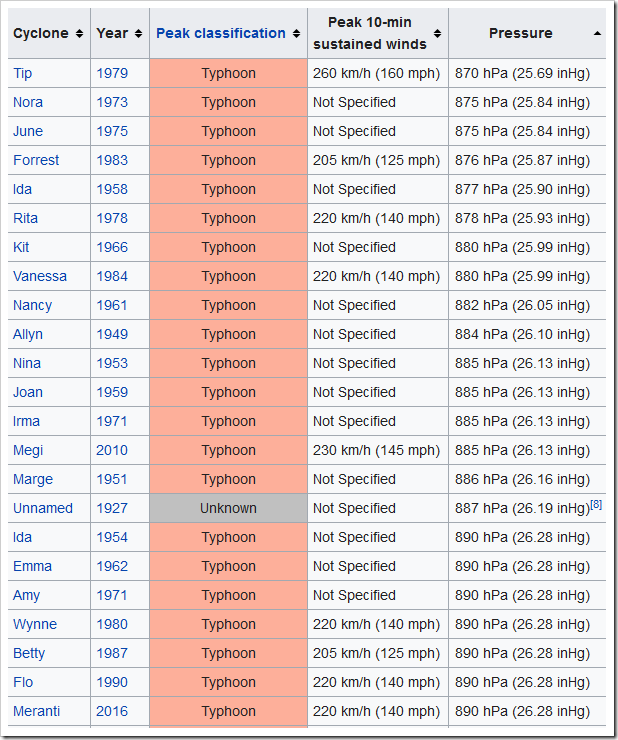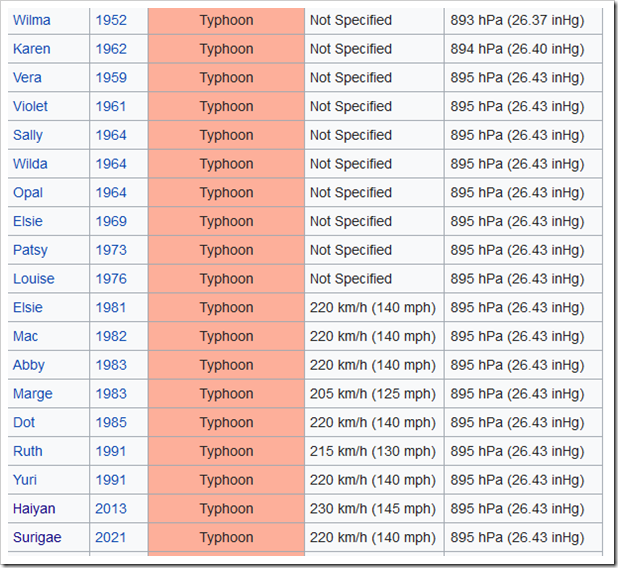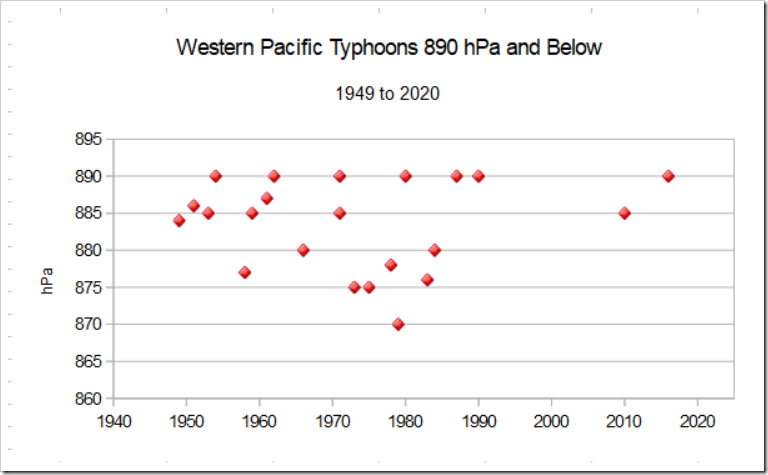Reposted from NOT A LOT OF PEOPLE KNOW THAT
By Paul Homewood

https://en.wikipedia.org/wiki/Typhoon_Haiyan#Meteorological_history
In his evidence to the Energy & Climate Change Committee in 2014, which I covered earlier, David King claimed:
“The most intense hurricane ever to hit land was Hurricane Haiyan”, the typhoon which hit the Philippines in 2013.
There has been much controversy about such claims, which are based on satellite estimates, that have of course only been widely available since the 1980s. Prior to satellites, monitoring of typhoons in the Western Pacific relied on airplanes, which were not able to cover the full ocean, and which also avoided direct contact with the strongest typhoons, for obvious reasons. Before that we only had land based anemometers, which were rarely located at the point of highest wind speeds, and which in any event would not survive such high wind speeds.
That is why the most important measurement in pre-satellite days was always central pressure. And here we find that Haiyan was a long way from being the most intense typhoon.


https://en.wikipedia.org/wiki/List_of_the_most_intense_tropical_cyclones#Western_North_Pacific_Ocean
Far from being the most intense, Haiyan is way down the list. There have been twenty four Western pacific typhoons which have been more intense than Haiyan, which is also tied with 16 others at 895 hPa. In other words, Haiyan only makes the top 51.
This list only dates back to 1927, so there have doubtlessly been many other, more intense typhoons on record before.
And it is not only Haiyan. Typhoon Goni, which hit the Philippines last year, is said to be the most intense landfalling storm, with winds of 195 mph. Yet its central pressure never got below 905 hPa, which does not even put it in the top 80 Western Pacific typhoons. There is clearly a disconnect between claimed wind speeds and central pressure.
It is true that pressure is not the only determinant of wind speed. Small, tightly wound cyclones can have high wind speeds because their isobars are closer together.
However, global warming theory predicts that warmer oceans will lead to more intense hurricanes, as measured by pressure. Clearly in the Western Pacific at least, this theory falls flat on its face.

https://en.wikipedia.org/wiki/List_of_the_most_intense_tropical_cyclones#Western_North_Pacific_Ocean
From a contemporaneous report :
“As of this writing, the storm is in the process of making landfall in the Philippines and it is moving west at 20-25 knots and estimated winds of 170 knots (195mph).
Hurricane expert Dr. Ryan Maue has been monitoring the Super Typhoon for the past several days and remarked about the historic nature of Haiyan. In this upper echelon of cyclone intensity, it is difficult to assign rankings or compare Typhoons due to inhomogeneous observing networks and tools. But it’s fair to say that Super Typhoon Haiyan is as intense as a tropical cyclone can get. “
Bear in mind that we have a very short historical record of Typhoon strength, and any claims that this is the strongest storm ever need to be qualified with that fact. Nobody has any credible record of typhoon strength back more than a few decades.
From <https://wattsupwiththat.com/2013/11/07/super-typhoon-haiyan-one-of-strongest-storms-ever-heads-for-philippines/>
You heard it here first 😉
need to educate this academic – probably not even born when Orson was around
Thank you, Paul, for preparing this, and, (assumedly) Charles or Anthony, for cross posting it here at WUWT.
Regards,
Bob
Even this list is all relatively recent storms. No measurements of either wind speeds or central pressures were available prior to the end of the 19th century. To get the central pressure, some poor schnook had to be on a ship in the middle of the hurricane’s eye and then survived either the first eyewall winds or the second eyewall winds.
All we know is that post-Colombian exploration there were a LOT of really bad hurricanes that destroyed a lot of ships and settlements in the West Indies. Nobody has the foggiest notion of the strength of those storms, from the late 15th century to the late 19th century .. let alone the storms that preceded the Colombian era.
The power of typhoons/hurricanes has to be experienced to get any actual idea of how destructive they are. Typhoon Haiyan doesn’t appear to be the winner in the speed competition, but I am sure it was impressive. I rode out a typhoon in an air traffic control tower, in July (?) 1969 in Vietnam. The typhoon was supposed to miss us but it veered, without permission, and came right over us. The tower had a placard that read “Abandon Tower at Wind Speeds of 90 Knots”. The wind blew right through 90 on its way to 111 knots. The tower was about 65 feet up in the air, and you could not get down due to the winds blowing through the open structure. Heavy rains, but an occasional view of airplanes, helicopter and roofs going airborne, again without permission (I keep mentioning this because in the Army you need permission for everything). Stay safe.
Permission to leave your post “NOT GRANTED” stay and enjoy the ride
“I rode out a typhoon in an air traffic control tower, in July (?) 1969 in Vietnam.”
Me, too! I wasn’t in a control tower, though. I was sitting by a creek that turned into a river right before my eyes. I think they said it rained 22 inches in 24 hours.
What David King is quoted as saying is
“The most intense hurricane ever to hit land was Hurricane Haiyan”
What is offerred here is a wikipedia list of measurements of peak intensity (by pressure) over sea. That does not contradict King’s statement about intensity on landfall.
But if Wiki is the authority, then what they say about Haiyan is
“At 20:40 UTC on November 7, Haiyan made landfall in Guiuan, Eastern Samar at peak intensity.[18] The JTWC’s unofficial estimate of one-minute sustained winds of 305 km/h (190 mph) would, by that measure, make Haiyan the most powerful storm ever recorded to strike land. This record was later broken by Typhoon Goni in 2020.”
Just what David King said.
Its not just that King compares wind speeds with hurricanes with no recorded wind speeds, it’s estimated. &plusmin; 20 km/h?
Wikipedia was not the authority. What a bloody childish comment. The references used in the article are. Did you check and find reason to question the numbers?
And as clearly stated, while central pressure is not a measure of sustained wind speeds, it’s what is supposed to get worse due to global warming and lead to stronger winds.
There are better records for central pressure. Its the “canary in the coal mine” and the “scientists” use estimated wind speeds for propaganda is what is being criticised.
“The references used in the article are. Did you check and find reason to question the numbers?”
The wiki quote I gave, saying exactly with David King said, had references too. But in fact I didn’t question the numbers. I just pointed out that they were not strength at landfall, which is what King was talking about.
You made a stupid comment about using Wikipedia as an authority.
The whole article is about what property to use in a comparison of previous storms. Its criticism of choosing estimated windspeeds. Windspeed at landfall being the worst choice.
““The most intense hurricane ever to hit land was Hurricane Haiyan””
Don’t you love it! He says “ever”. Unless, this person has knowledge of *every* Typhoon that has occurred on Earth, then he can’t be legitimately making a claim of “ever”, because of course, he has no knowledge of Typhoons beyond a few decades in the past. His claim is absurd. And you are promoting this imprecise language, Nick?
This is just more hyperbole about the Earth’s weather.
IIRC, The US ran hurricane hunters in the WPAC for years, but that stopped some time ago. Hence, most ocean readings are satellite derived I believe? History help anyone?
FWIW, Typhoon Tip was indeed a monster storm in size and intensity. Hurricane Patricia (EPAC), which had a hunter in it a lot, had peak wind speeds at 215mph and a pressure of 872 hPa.
Typhoonsizes – Typhoon Tip – Wikipedia
Looks like a bit of a cyclone drought from the 1990s onwards. Our children won’t know what cyclones are!
They will know better natural disaster than cyclone, if we could not stop the environmental changes. The climate changes have made a lot of effects on your lifestyle! Has the time come to rethink about the way we polluting the environment.The flirtymania lets the people know how to get engaged with the world. Thanks for sharing this post!
The BOM has this trend graph for Aussie region cyclones since 1970 and there is definitely a lower trend over that period.
Note that 2015 to ’16 season is the only time that no severe cyclone was measured over the last 50 years.
And Dr John Nott has stated that the last SUPER cyclone hit the NE Qld coast about 200 years ago. See ABC Catalyst program.
http://www.bom.gov.au/cyclone/climatology/trends.shtml
BTW here’s the ABC transcript for Dr Nott’s last SUPER cyclone 200 years ago.
See last 2 paragraphs for his quote. And there were any number of these SUPER cyclones prior to 200 years ago.
https://www.abc.net.au/catalyst/super-cyclone/11006020
Yes, Mother Nature is not cooperating with the Alarmist theory.
In Western Australia cyclone Orson was a very large cyclone in 1989 – even today people still jokingly refer to it as cyclone awesome
Following quote from Wikipedia
“the cyclone reached its peak intensity with winds of 250 km/h (155 mph 10-minute sustained) and a barometric pressure of 904 hPa (mbar).[1] Orson maintained this intensity for nearly two days before making landfall near Dampier.”
the real critical point to note is the wind speed duration – most quote a 3 second peak speed
This one was a sustained wind speed for 10 minutes
the other point to note was these wind speeds were recorded on offshore platforms onshore airports by anemometers which broke at this speed so the speed could have been higher
at one of the oil production terminals on an island the spinifex grass was driven into the building doors like darts
The impact of climate change on tropical cyclones cannot be assessed from the data for a single cyclone basin. All 6 cyclone basins must be included.
Please see
https://tambonthongchai.com/2020/09/20/a-failed-obsession-with-tropical-cyclones/
You’re amazing, what a fantastic resource!
Erm. Not sure Id be taking data from Wiki as its wrong. I live in the Philippines and witnessed Haiyan from Tacloban. Recorded gusts were sustained above 315kmh for more than 10min periods. I since moved to Manila and been studying weather systems here all year. Goni was a baby. Tiny diameter for a typhoon that grew massively in strength. As soon as it hit landfall over Bicol it died instantly. Its course took it south of us and had gone from a Cat6 to an LPA within 100km’s. It only crossed a spit of land 50km wide as well.
I rode out Tip tied to the pier at the Yokosuka Naval base,1979. Both main engines down for repair (maybe the reduction gear). USS Berkeley DDG-15. The rest of the battlegroup (Kittyhawk) had taken to sea a couple days before. Was quite the event.